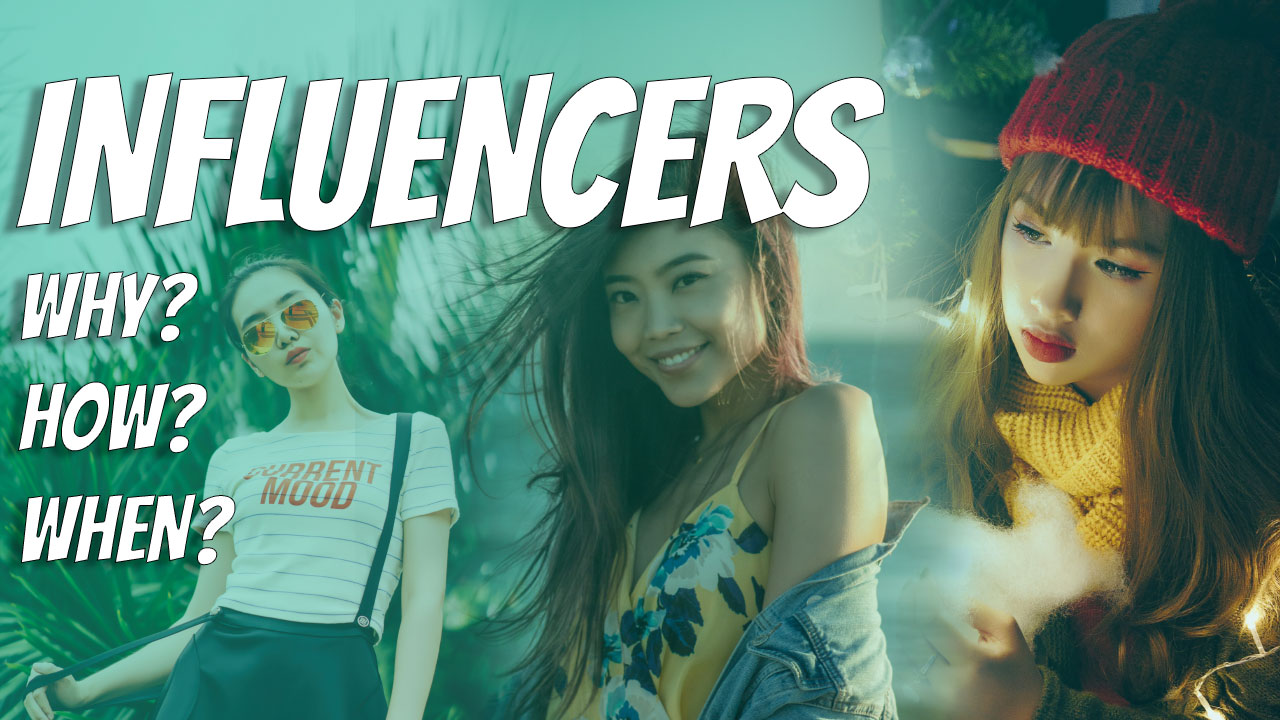
30 Jul Is influencer marketing effective in the ‘new norm’
Just a quick post on why it’s a bad idea if you’re a small business to use an influencer or Key Opinion Leader (KOL), but also let you know when you should consider using an influencer or KOL as part of your marketing mix to promote your product, service or business.
This post mostly talks through the lens of a small to medium business, however the principals still remain the same even if you’re a large enterprise organization.
In general, influencers and KOLs are great because they give you an ability to tap into a highly engaged sub-community on social media which can help towards reaching your campaign objectives.
For this post, I’m going to break it down between a few things:
- When to use and not use an influencer or KOL
- Vanity metrics
- The longevity of a post on social media (stories)
Then I’ll tell you what to look out for if you do decide to use an influencer to make sure you are spending correctly and that it’s going to hit your objectives.
Listen to the article
Watch the video
Who shouldn’t use an influencer or KOL
- If you’re a small businesses affected by COVID and your business is dependent on your customers coming into your store to purchase whilst there’s a lockdown – Then don’t use it
- If you aren’t spending on your team to improve their skills or platforms to support – i.e. Search Engine Optimization (SEO), social listening platforms, effective email marketing courses
- If you’re not spending any money on paid ads already – Search, Display or Social
- If you’re current marketing is all of the place and you can’t properly measure your own performance digitally – Then don’t use it
- You are down to your last $1,000 and you’re hoping for a miracle – Do NOT use an influencer
When you should use an influencer or KOL
- The influencer or KOL’s audience aligns to your product or service
- Your campaign has some really clear objectives on the role of influencers or KOLs towards your performance
- Cost per thousand impression (CPM), Cost Per Click (CPC) is satisfactory
- The influencer or KOL cause/mission aligns to your brand
Below are a couple of common objections businesses make when they want to use an influencer or KOL.
But.. I see they have a lot of followers and likes on their social channel
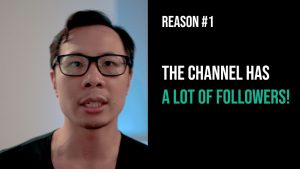
Reason 1: The channel has a lot of followers
Some businesses determine the worth of an influencer on the basis of their vanity metrics – subscribers, followers, likes on their social page.
They think that because an influencer has 2,000 Instagram followers for instance, that these same 2,000 followers will see that post featuring your product or service.
That’s further from the case.
The average reach on posts for Facebook according to Hootsuite in 2021 is 5.2% and it’s been steadily going down since 2017 when it was 7.7%. Instagram business accounts fare worse at 0.85% in 2020, but if you look at a post from Ignite Social Media, they report through their findings that the average reach is about 9%.
Either way as Facebook and Instagram platforms continue to mature, expect organic reach and engagement to continue to slide downwards.
So, going back to the example earlier, their 2,000 or even 20,000 followers on their channel will not equate to 100% or even 50% reach, which you then need to determine for the money I spend, and the reach I get for that post, how much will I be paying from that influencer’s community to see my product or service?
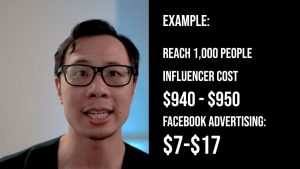
influencer marketing cost versus paid media ads Facebook
Take an example – Your product might fit within Travel & Hospitality sector
- If you paid $100 to an influencer for a post on Facebook
- Influencer / KOL has 2,000 followers
- Facebook reach 5.2% (Source: Hootsuite)
- Potential reach of your post: 106 (2,000 x 5.2%)
- Cost per reach: 94.33 cents ($100 / 106)
- If you wanted 1,000 to view that post of your product 0.94 x 1000 = $940
But if you were to just use Facebook Advertising, even if you just use the simple settings to ‘boost’ your post, you will achieve 1,000 people much cheaper and quicker than your influencer.
If we use Cost Per Impressions (CPM) as a metric, impression is the amount of times your post / ad gets shown. It doesn’t necessarily mean a unique individual sees that ad, but it means that your post / ad gets shown a certain amount of times within the confines of your target audience.
You can find the average CPM for Facebook broken down in different industries, but for this example, let’s use Reveal Bot, which indicates during 2020 the average CPM was $14.67, you can search for others, like Webfx has the average at $7.19.
So, back to comparison. Pay $100 plus product costs for 106 reach versus paying $14.67 or $7.19 for 1000 impressions.
Of course if you can get a better performing CPM through better targeting and subsequently improve your CPC or CPA but it depends on your objective your target audience.
But.. it’s just product I have at hand that I can give to them
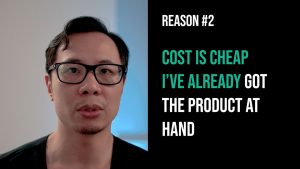
Cost is cheap as I have the product with me to handout
Sure the production cost of your product might be low (e.g. 10% of your RRP), but then you got to factor in your personal time to explain the product, ship the product to them, answer any follow up questions and review (if any) the post before your influencer publishes it.
And, if your time is worth $100 per hour, then it adds up over time and you’re better off using Ads to promote it to gain a wider reach.
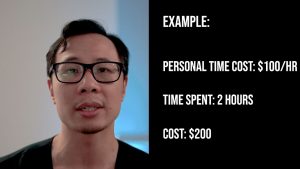
Influencer marketing cost versus personal time cost
Here’s a couple of other factors to consider if you’re thinking of using an influencer or KOL to promote your product or service:
- Content created for social media is ephemeral, meaning it will only last a short time through the algorithm on the platform and for stories, these content pieces lasts for only 24 hours
- Depending on the type of influencer or KOL you engage with (A, B or C-Level) you are going to have a small degree of control on what they talk about your product or service. You may not like it, but you don’t really have that control with that creator
- Have a look at your existing marketing mix – overall brand wise vs specific and timely campaigns, is there synergy between them?
What should I do instead?
Besides investing into various digital platforms to help you understand your audience needs, wants and frustrations, investing money into your team to improve their skills as marketers is super important.
There are a lot of resources available you can subscribe to from Skillshare, Udemy to even free YouTube tutorials, there’s really no real excuse when it comes to investing into your staff or yourself.
SEO or Search Engine Optimization is by far the cheapest way to improve traffic and exposure over time. It does require up front work and patience, but it does pay off in the long run.
In addition, you can balance that with paid search which is good as it targets people who are actively searching (with intent) your product or service and you can even display the ads based on geographical proximity (local area marketing).
But I still want to use an influencer or KOL
Depends on your budget you’re willing to spend on the influencer, but the obvious questions you want to ask your influencer or KOL if you’re looking to directly engage with them
- What do I get for spending with you?
- Am I getting a shoutout through a post? Which channels?
- Story uploads
- Newsletter placement
- Are you getting quality link backs
Also ask them about their performance stats. If it is a real influencer and they are charging lots of money (=>$300-500 a post), then they should have the stats to back it up.
So couple of performance stats to think about:
- Average engagement rate per post
- What’s their organic reach rate
If it is a website post
- Visitors (Sessions)
- Average time spent on page
- Click throughs
If it is a email newsletter and depending on the placement
- Open rate
- Click through rate
- Where is my brand positioned
There are agencies with a suite of influencers that deal with the negotiation of fees and performance, but you’re typically paying a bit of a premium and it’s trial and error over a period of time to find an agency with the right amount of influencer / KOLs to work with.
There’s just a few things to consider if you are looking to incorporate an influencer or KOL into your marketing mix and why type of questions you should be asking.
